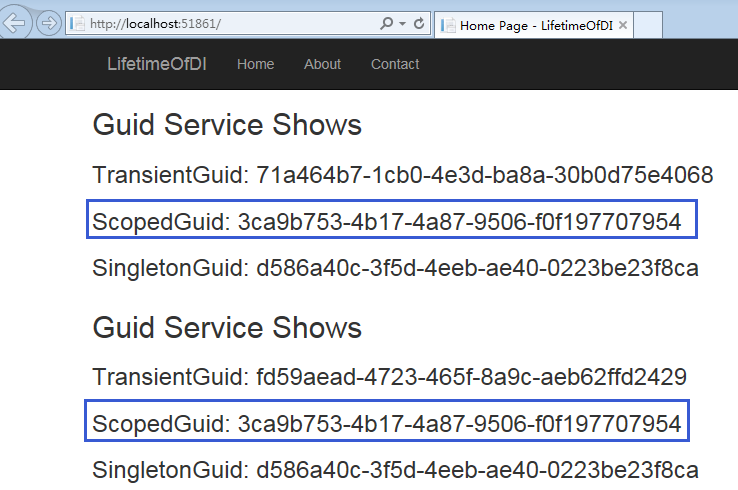07、NetCore2.0依赖注入(DI)之生命周期
NetCore2.0依赖注入框架(DI)是如何管理注入对象的生命周期的?生命周期有哪几类,又是在哪些场景下应用的呢?
------------------------------------------------------------------------------------------------------------
写在前面:这是一个系列的文章,总目录请移步:NetCore2.0技术文章目录
------------------------------------------------------------------------------------------------------------
一、生命周期的分类
来看看系统依赖注入框架(DI)的开源代码:
namespace Microsoft.Extensions.DependencyInjection
{
public enum ServiceLifetime
{
Singleton,
Scoped,
Transient
}
}
从源码可以看出,依赖注入框架(DI)支持三种生命周期管理模式
- Singleton
单例模式,服务在第一次请求时被创建,其后的每次请求都沿用这个已创建的服务。我们不用再自己写单例了。
- Scoped
作用域模式,服务在每次请求时被创建,整个请求过程中都贯穿使用这个创建的服务。比如Web页面的一次请求。
- Transient
瞬态模式,服务在每次请求时被创建,它最好被用于轻量级无状态服务。
二、重现三种生命周期的应用场景
首先我们创建三个服务,用来提供GUID。
using System; namespace LifetimeOfDI { public interface IGuidService { Guid Id(); } public interface ITransientService : IGuidService { } public interface IScopedService : IGuidService { } public interface ISingletonService : IGuidService { } public class GuidServiceBase : IGuidService { private readonly Guid _item; public GuidServiceBase() { _item = Guid.NewGuid(); } public Guid Id() { return _item; } } public class TransientService : GuidServiceBase, ITransientService { } public class ScopedService : GuidServiceBase, IScopedService { } public class SingletonService : GuidServiceBase, ISingletonService { } }
然后用VS2017新建一个Mvc项目,在Startup类中注册这三个服务
public void ConfigureServices(IServiceCollection services) { services.AddTransient<ITransientService, TransientService>(); services.AddScoped<IScopedService, ScopedService>(); services.AddSingleton<ISingletonService, SingletonService>(); services.AddMvc(); }
既然注册了,在Controller中就可以使用这些服务了,我们采取构造函数注入的方式,来给Controller注入这些服务
using Microsoft.AspNetCore.Mvc; namespace LifetimeOfDI.Controllers { public class HomeController : Controller { private readonly ITransientService _guidTransientService; private readonly IScopedService _guidScopedService; private readonly ISingletonService _guidSingletonService; // 构造函数注入 public HomeController(ITransientService guidTransientService, IScopedService guidScopedService, ISingletonService guidSingletonService) { _guidTransientService = guidTransientService; _guidScopedService = guidScopedService; _guidSingletonService = guidSingletonService; } public IActionResult Index() { // 传GUID给页面 ViewBag.TransientItem = _guidTransientService.Id(); ViewBag.ScopedItem = _guidScopedService.Id(); ViewBag.SingletonItem = _guidSingletonService.Id(); return View(); } } }
在Index.cshtml页面中显示这三个GUID
@{ ViewData["Title"] = "Home Page"; } <div class="row"> <div> <h2>Guid Service Shows</h2> <h3>TransientGuid: @ViewBag.TransientItem</h3> <h3>ScopedGuid: @ViewBag.ScopedItem</h3> <h3>SingletonGuid: @ViewBag.SingletonItem</h3> </div> </div>
我们启动两个浏览器,可以看出单例模式的Guid在两个浏览器中是一致的,而且,即使刷新浏览器,也不会改变;另外两个生命周期的服务因为每次刷新都发起了一次新的请求,所以Guid都不同。

三、使用局部页面技术验证作用域生命周期的特点
上一节没能验证Scoped类型生命周期,因为每次刷新都发起了一次新的请求。我们需要验证一个Web请求,对服务的多次使用。如何验证呢?这里我们借助局部页面技术。
新建一个局部页面IndexPartial.cshtml,在局部页面中引用我们的自定义服务命名空间,并注入三个服务,分别显示其Id。
@*引用自定义接口的命名空间*@ @using LifetimeOfDI @*依赖注入*@ @inject ITransientService TransientService @inject IScopedService ScopedService @inject ISingletonService SingletonService @*输出服务提供的Id*@ <div class="row"> <div> <h2>Guid Service Shows</h2> <h3>TransientGuid: @TransientService.Id()</h3> <h3>ScopedGuid: @ScopedService.Id()</h3> <h3>SingletonGuid: @SingletonService.Id()</h3> </div> </div>
在Index.cshtml页面中两次引用这个局部页,这样就可以展示,一次请求两次调用服务接口的场景。
@{
ViewData["Title"] = "Home Page";
}
@Html.Partial("IndexPartial")
@Html.Partial("IndexPartial")
看看效果吧

从效果看,作用域生命周期内的Id在一次请求的多次调用中保持了一致性;而瞬态生命周期则每次调用都不同;单例生命周期则不用说了,不同请求的多次调用都不变,更不用说相同请求了。
至此,我们理解了三种生命周期的的特点,在业务开发中可以按需使用了。




